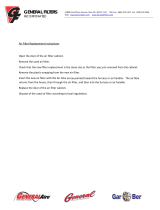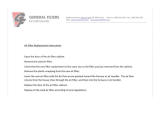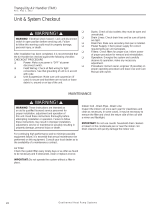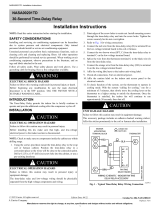
7
CAUTION:
This unit uses refrigerant R-410A. DO NOT use
any other refrigerant in this unit. Use of another
refrigerant will damage the unit.
• Every effort should be made by the installer to ensure
that the fi eld installed refrigerant containing components
of the system have been installed in accordance with
these instructions and sound installation practices to
insure reliable system operation and longevity.
• Always refer to the installation instructions supplied with
the outdoor unit for piping requirements. The suction
and liquid lines must be sized in accordance with the
condensing unit specifi cations. See Figure 4 (page 13)
for liquid and suction line locations.
• When connecting refrigerant linesets together, it is
recommended that dry nitrogen be fl owing through the
joints during brazing. This will prevent internal oxidation
and scaling from occurring.
• Refrigerant tubing should be routed in a manner that
minimizes the length of tubing and the number of bends
in the tubing. It should be supported in a manner that
prevents it from vibrating or abrading during system
operation. Tubing should be kept clean of foreign debris
during installation.
• If precise forming of refrigerant lines is required, a copper
tubing bender is recommended. Avoid sharp bends and
contact of the refrigerant lines with metal surfaces.
• Refrigerant lines should be wrapped with pressure
sensitive neoprene or other suitable material where
they pass against sharply edged sheet metal.
CAUTION:
Before brazing the B6BW, remove the core from
the service port. Failure to comply may result in
leakage at the service valve. Replace the core
and cap once brazing is complete.
• The B6BW air handler is charged through service valves
on the end of the liquid tube for each circuit. These must
be removed before brazing the line sets.
System Depressurization
1. Remove the cap from the end of the liquid line.
2. Verify pressurization by depressing the Schrader valve
on the end of the liquid line. Listen for any escaping gas.
If there is no pressure, test the unit for leakage.
• If leakage is found, clearly mark the location of the leak
and return the unit to the distributor for processing.
• If no leaks are found, the air handler may be installed.
3. Depress the valve to relieve all pressure from the coil.
Connecting the Linesets
Notes: Before proceeding, perform steps 1 - 3 in the
System Depressurization section.
1. Route and cut both lineset tubes to proper length in
accordance with the outdoor unit specifi cations. Verify
the ends are round, clean, and free of any burrs.
2. Connect the suction and liquid lineset tubes.
CAUTION:
It is recommended that a wet rag be wrapped
around the suction line before applying heat.
Failure to keep components cool during brazing
may result in structural damage, premature
equipment failure, or possible personal injury.
3. Braze the individual connections with dry nitrogen fl owing
through the joints. This will prevent internal oxidation
and scaling from occurring.
4. Wrap the refrigerant lines with pressure sensitive
neoprene or other suitable material especially where
the lines enter the opening in the sheet metal.
5. Evacuate the system of moisture and non-condensables
to prevent low effi ciency operation or damage to the
unit. The suggested range of evacuation is 250 - 500
microns.
6. Charge the system with refrigerant. Refer to the
outdoor unit installation manual for additional charging
instructions.
7. Check the system for leaks, including the lineset and the
brazed joints. NOTE: Apply a soap and water solution on
each joint or union with a small paintbrush. If bubbling
is observed, the connection is not adequately sealed.
8. Properly dispose of all removed parts.
Condensate Drainage
The drain pan that is supplied with this air handler contains
a primary and secondary drain fi tting. The condensate is
drained from the unit through two 3/4” male pipe fi ttings
located on the front side of the unit as shown in Figure
2 (page 8).
CAUTION:
The air handler must be level to ensure proper
condensate drainage. An unlevel installation
may result in structural damage, premature
equipment failure, or possible personal injury.
• The method for disposing of condensate varies according
to local codes. Consult your local code or authority
having jurisdiction.
• The drain lines can be routed out the bottom, left or right
side of the air handler, but must maintain a downward
slope to ensure proper condensate drainage. If the
bottom access panel is moved to the front (for bottom
return air), the condensate drain tubes must be routed























